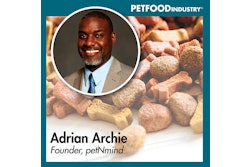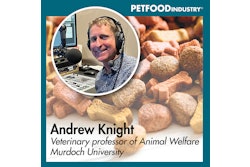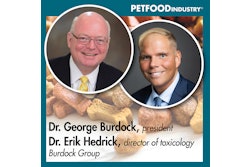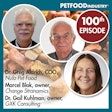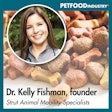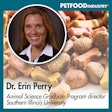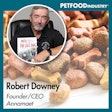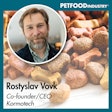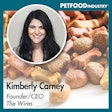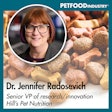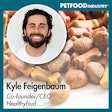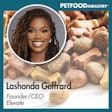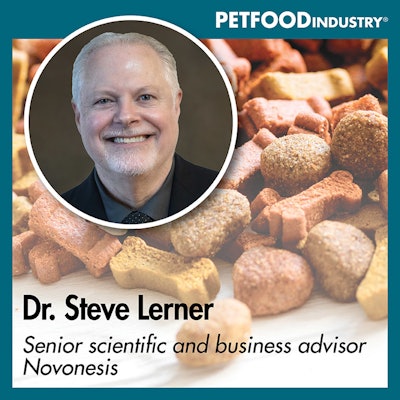
Join host Lindsay Beaton and senior scientific and business advisor for the Animal and Plant BioSolutions division of Novonesis, Dr. Steve Lerner, as they explore the importance of probiotics, prebiotics and postbiotics in promoting overall pet health, the science behind these dietary supplements and what pet food manufacturers need to know to make them an effective part of their product.
The below transcript is from Episode 76 of the Trending: Pet Food podcast. Biosolutions are essential for gut health, but the pet food industry faces challenges in ensuring their effectiveness. Host Lindsay Beaton and Dr. Steve Lerner at Novonesis, tackle biosolutions in pet food and discuss the importance of understanding that not all these dietary supplements are the same. You can find the episode at Trending: Pet Food, on SoundCloud or on your favorite podcast platform. This episode originally aired on December 5, 2024.
We want to thank Coperion for sponsoring this podcast. For over 50 years, Coperion has supplied the most recognized pet food brands throughout the world with state-of-the-art dry bulk material handling systems.
Lindsay Beaton – editor, Petfood Industry magazine, and host, Trending: Pet Food podcast: Hello, and welcome to Trending: Pet Food, the industry podcast where we cover all the latest hot topics and trends in pet food. I’m your host and editor of Petfood Industry magazine Lindsay Beaton, and I’m here today and I’m here today with Dr. Steve Lerner, senior scientific and business advisor for the Animal and Plant BioSolutions division of Novonesis. Hi Dr. Lerner, and welcome!
Dr. Steve Lerner, senior scientific and business advisor for the Animal and Plant BioSolutions division of Novonesis: Hi Lindsay. Very happy to be here.
Beaton: In case you’re unfamiliar with Dr. Lerner or Novonesis, here’s what you need to know.
Dr. Steve Lerner is currently responsible for mentoring less experienced technical services, marketing and sales professionals in a joint effort to bring more sales, profit and other significant results, like engagement and retention, to Novonesis.
He has a Ph.D. in Reproductive Physiology from West Virginia University and a post-doctoral Fellowship in Molecular Genetics from the University of Southern California. He holds an M.S. in Biology/Embryology from West Virginia University and a B.S. in Zoology from University of Maryland. Prior to joining Christian Hansen, now Novonesis, Steve worked at Nutrition Physiology Company as vice president of Product Development and Commercialization.
Novonesis is a leading biosolutions partner committed to fostering sustainability and enhancing planetary health. The company integrates deep industry expertise with innovative biosolutions to tackle pressing environmental challenges and enhance business efficiency. By leveraging advanced probiotics and enzymes, Novonesis not only improves animal health and performance but also drives significant improvements in sustainability for its clients.
Dr. Lerner’s education and experience in nutrition and biosolutions, as well as his current role as an educator at Novonesis, are why I’ve brought him on today to answer this question: What roles do biosolutions, particularly probiotics, play in the pet food space?
There's a lot going on right now in terms of probiotics, prebiotics, postbiotics and picabiotics. I was wondering what your take is on what you think has led to the rise of biosolutions like these in food spaces in general, to say nothing of pet food.
Dr. Lerner: If you look at the understanding of microbiology 30 to 40, years ago, when we heard the term “germs” or “bacteria” or “bugs,” our solution was disinfection -- kill all organisms. The rise of hand sanitizers and bleaches available for cleaning was the rule. Now we have a far superior understanding that we co-habit the planet with trillions upon trillions of these microscopic organisms. In fact, on us and in us, we carry about 40 trillion of these.
Now everyone is understanding that life as we know it involved the proper functioning of our microbiome, which is all the organisms in and on us. The majority of those are bacteria. As our understanding of microbiology improved, and we started talking about microbiology and probiotics for gut health. We start talking about, what does that mean to have a robust and well-balanced microbiome?
We begin seeing these yogurts advertised on TV in the last couple of decades, indicating that you eat these yogurts with these active cultures, and you can establish gut health. Our populace has begun to accept that microbiology can be part of their lives, to have them have better gut health, better digestive function. They, of course, believe if it's good for them, then it's good for all the animals in their care.
We have great evidence that if you, yourself are a consumer of probiotics, then your chance of providing probiotics to your fur babies goes up. The trend is simply related to a better understanding of microbiology in our current environment, rather than what it was 30 to 40, years ago.
Beaton: Now, I remember when Activia first came out. The commercials were saying all the right things, and it was very heavily marketed towards gut health at a time when we didn't necessarily know what that meant. How much of the acceptance today do you think is genuine education on the consumers part, and how much of it is marketing acceptance? Because the message got out there a while ago, and just kind of never let up. Where's the gap in there, and is it closing?
Dr. Lerner: Well, Lindsay, you know, full well, and as a former marketer, when your audience has heard it at least seven times, then they begin to finally internalize it. I also like the expression, “When you have said it so many times, then the next time you say it, you're going to become physically ill, your audience has just begun to hear it.”
What I believe wholeheartedly has caused this acceptance of the science of probiotics is when physicians, medical doctors, begin prescribing probiotics when their patients have been on an antibiotic, when they begin to indicate the use of probiotics when their patients are experiencing stress. It only takes a few times as an individual to say, “Hey, when I'm on probiotics, I feel better. I don't perceive the impact of stress as well. I don't have digestive upset. My stomach isn’t sour, and I am not flatulent.”
I believe human nature is proof-by-example as a rule. They began to eat Activia yogurt, and they noticed a change, a difference. They began to consume probiotics daily, and the quality of their gastrointestinal health improved.
Now, I will also tell you, and I'm hoping we get into the conversation later today, that there is now tremendous evidence coming, mostly out of medical literature, that the quality of our microbiome and the capacity of the microbiome, particularly in our colon, to make a chemical called short chain fatty acids -- these little two to six carbon molecules that are the main source of energy for the cells that line our colons -- that are actually the first step in what is now referred to as the microbiome-gut-brain axis. There's now tremendous evidence that what happens in your colon, being mediated through the vagus nerve to the brain, or through the secretion of hormones or the influence on the immune system, can impact the way you feel and your cognitive behavior.
This is true for us, and now there's scientific evidence in our pets, where animals that are anxious can be provided probiotics, and the signs of their anxieties diminish. Animals can be expressing bad behaviors or unwanted behaviors, and when they're given probiotics, those behaviors diminish. We know that. We have studies showing when you have a healthy, robust microbiome supported by the consumption of probiotics, the amount of serotonin you produce in your gut goes up.
About 90% of serotonin is produced in our intestinal tract. Serotonin is the hormone of well-being. Every time you can increase the secretion of serotonin, you feel better. Every time you can reduce the secretion of corticosterone, the hormones of stress, you perceive stress differently. We have evidence that probiotics can accomplish those things mediated through change in the quality of our microbiome.
It is this scientific understanding, not marketing puffery, not just good marketing, but it's true science that have led people to make a choice to consume probiotics.
Also, their availability is far better than when I was young. Significantly, large spaces on shelves in grocery stores offer probiotic solutions. We can talk later about what makes one probiotic good or one probiotic better than others, but that's a conversation for later.
The opportunity to find affordable probiotics, to consume them, and to realize a benefit, I believe, is what has driven the growth in this market. It is true efficacy of the product, rather than its fufu dust, but people have been convinced that it's useful.
Beaton: Now you and I had this conversation several weeks ago, and it was this part that convinced me that we needed to do a podcast and dive deeper into it, because the gut-brain axis is such a new idea in terms of it expanding into the everyman consciousness, outside of academic circles, and making its way into general consumer conversations. There's so much going on right now. Was this connection discovered incidentally to other research that was being done on probiotics and gut health, or was it intentional research to see if there was something more there that got us here? When did the research start in the pet space?
Dr. Lerner: Absolutely. The way research happens is scientists/ physicians make an association. They can see that for patients where there's an obvious problem with the quality of their digestive system, they have chronic irritable bowel. They have, God forbid, hemorrhagic bowel. There's a problem. There were other obvious connections, from everything from gingivitis and oral health problems to Alzheimer's and autism, so they could, quite correctly, begin to build these at least contemporary links between impacts that are going on in the digestive system and whole-body physiology.
Then you ask the question, “Well, how is it that something going on in our gut can impact homeostasis of the entire body?”
Then you begin diving deeper into the physical, chemical properties of physiology, and say, “Okay, are there any mechanisms that would make this true?” You begin looking what is produced in the gut that might be received and pulled into the intestinal tract.
One answer is short chain fatty acids. This is acetate, butyrate, propionate. Those are the most common. They are three-, four- and five-chain carbon strings. They're carbon, hydrogen, oxygen, like every sugar they serve as an energy source on the cells that line the intestinal tract of mammals, including those mammals we have as fur babies.
There are receptors that pull these short chain fatty acids into those cells against a concentration gradient. They are called sodium and acid dependent monocarboxylate transporters -- a beautiful big name, which we always do in the sciences, add jargon. You can just think that there is something that is looking for, at least euphemistically, this short chain fatty acid. It grabs it, it pulls it into the cell as a major source of energy, but when it pulls these short chain fatty acids into the cells that line our intestines, it can cause a nervous transmission via the vagal nerve to our brain that says, “All is good. I am getting what I need out of the gut.”
When these molecules are received by specialized intestinal cells during a class of enteroendocrine cells – “entero” signifying their location in the intestine and "endocrine" referring to their hormone-releasing capability -- then the reception of short chain fatty acids can cause production of hormones. Hormones like serotonin, glucagon and peptide. One that is now in the news, being related to Ozempic and diets and the loss of weight, can cause the secretion of peptide. Why? Why? Which is involved in satiety? When you feel satisfied, it is the secretion of Peptide YY that goes into your bloodstream. It can affect the brain.
We also know that these short chain fatty acids can move out of the cells that align our intestinal tract into our bloodstream. When they get into our bloodstream, they can be carried to the liver, where they can impact mitochondrial function and the cleaning of our blood. It can impact the pancreas and the secretion of insulin and glucagon. It can impact brown fat in those animals that have brown fat to release energy. It can impact immune cells and help with the differentiation of the T helper cells, part of our adaptive immune system.
You can see that these simple molecules that when they are binding to our intestine, they also call the atrial fibrillation to improve in quality so we don't have a leaky gut because of short chain fatty acids.
The audience may be asking the question, “Well, why on Earth would something that happens in our gut be a signal for actions in our body?” But we think about it. The bacteria have been on Earth for 3.2 billion years, evolving all the time. All higher life forms on Earth co-evolved in the presence of bacteria. It wasn't as though there were humans with no bacteria. Then we started eating. We got bacteria. We developed in the presence of bacteria. It only makes perfect sense that the 40 trillion organisms that inhabit us would have a way of communicating to their host.
I say communicating. It doesn't have to be a contrived, well-thought-out signal, but it could certainly be something that when it was communicated, the host did better. When the host does better, the bacteria that populate the host do better. All they care about is being kept in low oxygen, in the dark, well-fed and occasionally shed back out into the environment to continue to propagate.
We do that extremely well for them. We may think we carry them around. They find us to be an excellent transport system.
As evolution happens, in science, first, you invest billions of dollars to do this type of research in humans, where there are investors that would look for those type of solutions to bring to patients, particularly these are biosolutions. They are not new drugs or not new chemicals. They are safe, effective organisms that confer a benefit to the host.
Then you begin extending that research into animals. It can be for the pets that we care for or for all the production animals in our care, because if you can improve the quality of their lives, then you're more efficient at producing meat, milk and eggs, and the more efficiency that drives profitability.
The number of mouths we're going to have to feed between now and 2050 is going up. Whether that's 8 billion, 9 billion, 10 billion, I don't know, but it will be more than it is today. If we do not continue to look for ways to improve the efficiency that we produce food, that's going to be a problem.
Thinking about us and those that we care for, our families and our fur babies, this is clearly where we can bring the best science to bear, because the best thing about someone else doing it first is you can leapfrog right to the best solution. You can find those probiotics that are most effective in the target animal, whether it's dog or cat or ferret or whatever.
Beaton: How refined are we in that regard?
Dr. Lerner: We now look for organisms that can bring to bear a set of modes of action. Let me explain this. We have bacteria based on their genetics. We know they are very good at producing digestive enzymes. The way many probiotic organisms work is they are usually bacilli in pet foods. Bacilli dominate the marketplace. Bacilli are motile organisms. They move. They evolved out of dirt. I like to think about them is mobile hunter killers. They are looking for food every second of every day, and they are out competing those microorganisms in their same bio niche.
The way these organisms work is they constantly are secreting a peptide, called an auto-inducing peptide. I think about it like a pheromone. They're sending this molecule out into the world. They and all the organisms like them, have receptors on their surface for those molecules. When those molecules bind to those receptors, it stimulates the production of more of that same it's an auto-inducing system, so they swim along a concentration gradient trying to find others like themselves. When they find those in this process is called quorum sensing, if you're into the modern biology, these organisms come together. As they grow in number, they form a quorum or a biofilm, and that congregation alters the gene expression so that together, they begin secreting molecules that anchor them in place, kind of a cement. They form this mature biofilm. Then in that microenvironment, the enzymes they can produce are extremely high.
You can select individuals that produce enzymes to ensure that you get proper digestion of feed or dog food or food. You can also look for organisms that are very good at producing short chain fatty acids or directly causing the quality of the tight junctions between the cells of our intestine to improve in quality, so that there's no chance of material that's moving through our intestinal tract from leaking into our bodies.
When we have a leaky gut, we can become septic, we get a blood infection, and it can certainly lead to morbidity and death. We want to keep everything that's moving through, and that barrier function might be one of the other modes of action that we look for in our organisms. We then want to look for organisms that are very good at producing anti-microbial peptides, because we want them to compete against the potentially harmful organisms that we might pick up inadvertently.
Look at dogs. Dog finds a dead bird in the yard. First, it's going to roll all over it, then it's going to eat it, right? It might take in some material that would be certainly noxious, not make it sick. Wouldn't it be lovely if the digestive system would help protect that individual from the potentially harmful bacteria that it consumed?
Healthy dogs, they never miss a beat. They eat it. Maybe they'll regurgitate it if it's fat. If not, it moves right on through them, and you never know.
You look for probiotic organisms that exhibit the modes of action that you're looking for. Then you pick a strain, which is an individual organism and all its trillions and trillions of nearly identical clonal copies, and you put that in a set of organisms that you now feed as a probiotic.
Let me talk about strain just for a moment and use dogs as an example. I'm going to suggest to you that we pick bacteria because of certain genetic gifts that they have, and when they express those gifts, they're very useful for a particular purpose, the production of enzymes, the production of antimicrobial peptides, the production of things that cause an improvement in the barrier function, the improvement in serotonin.
If I had to pick a dog, an individual dog, for a particular purpose… now, all dogs on planet Earth, if we look at genus and species, they're Canis lupus. We call them a subspecies designation of familiaris because we control their breeding, because all wolves on planet Earth are also Canis lupus.
Now, you can tell that I'm a zoologist by background. When you look at genus and species, all dogs are Canis lupus, but your job is to find an individual dog to help a team of rescuers in the Swiss Alps, find downed skiers in deep snow and then rescue them. Well, you could think about what dog that might be. It might be a Saint Bernard, a giant dog, heavy set, well boned, long legs, double coat of fur. Could be a Bernese Mountain Dog. These might be viable candidates, because the genetic gifts that they possess are well made for the task at hand. You might pick Cavalier King Charles Spaniel; you might pick a Chihuahua. They are both Canis lupus, but their genetic gifts are certainly different than the gifts bestowed upon Bernese Mountain Dogs and Saint Bernard's for that task.
If you want to keep the inner contents of your purse warm, then a Bernese Mountain Dog would be a bad choice. A Chihuahua or a Papillon would be an ideal choice. If you want a traveling companion and you want to take your fur baby everywhere you go, then a Cavalier King Charles Spaniel that sits nicely in the case is very specific in nature, might be the ideal. If you could clone dogs like you could clone bacteria, then you could find the ideal specimen for that particular purpose and clone it to be the best example for that job.
Thankfully, we don't clone pets, but you understand the analogy, and I think that's a very durable way of thinking about strain of bacteria. When you see on the label Bacillus subtilis, that's a genus and species. Doesn't really tell you much.
Let's take another one. You want to have a life partner, so knowing that there are Homo sapiens, right? Any Homo sapiens off the street could be my life partner, because that's what I want to choose, right?
It seems so ridiculous, but unless you understand the specific biology of the probiotic formulation that you're consuming or providing to your pets, then you're missing an opportunity to be informed about why one might be better than another. That selection of strain is clearly where the science currently is, and how the best pet food companies make their selections for probiotics to include in their offerings.
Beaton: Let's talk about that a little more, because there are a lot of different delivery methods that I've seen for probiotics. You can put it into food. You can put it into a treat. The supplements area of pet is exploding right now. I must believe that manufacturers and formulators don't necessarily have all this knowledge yet, and that suppliers might be doing a lot of the research or might be on top of it, because they're the ones getting the probiotics, the appropriate probiotics, to the manufacturers, who then get it out to the consumers.
What is that relationship like right now? Where does the education burden fall? How do you get everybody on the same page when so much research is happening right now, when you have to consider what are the viable options for providing probiotics and you're a pet food manufacturer, a major pet food manufacturer, and you are going to include in your offering on the shelf some lines that include probiotics.
Dr. Lerner: Well, the first thing you must consider are those organisms going to withstand my process of making the pet food. If they're going to be put into pelleted kibble, then lactobacillus organisms, or lactic caucus organisms, are not going to survive the pelleting process. You would then look for those organisms that can be provided in spores, which is why Bacilli are very popular genus to include in many bagged foods.
These spores, as long as they're kept dry, will exist forever. There are Bacillus spores, and I'm exaggerating slightly, forever is a long time. But there are Bacillus spores that have been found in ancient grain cribs in Egypt, where when they're brought back into a lab, they're still viable after a couple thousand years.
You can provide Bacillus organisms, but the science may say it is lactobacillus in combination with Bacillus organisms that might be most efficacious. Then you must consider, do I put that in a freeze-dried packet to be top dressed? Can I put that into a chew that is never heated beyond 100 degrees?
You begin to look for other viable options for providing the probiotics, therefore the manufacturer and their various lines to the market will mandate the types of solutions they can provide. Which is why many, if you're just a pet food manufacturer, don't get into the treat space; you don't get into any other additive space, then maybe Bacilli are your best choice. You would go to the suppliers and ask, “Which probiotics do you believe to be the best?”
Let me say at this time for the record that if you have chosen to use a probiotic from any reputable company, you have made an exceptionally good choice. There are many good probiotics. There are many reputable companies that provide probiotics, and if you've chosen to consume some, that's great. I can tell you, as an antidote, my wife takes probiotics with me every day. It took her about three months to find the probiotics she believed works best for her, and she was able to say, “For this month, I took it, and it's not as good as this one.” Then she moved back, and she's now on one every day, and loves it.
I think the same thing should be true for us and all of those in our care, that it might be one brand of pet food, one set of probiotics could be better based on the genetics and the environment that individual is in. That said, when you look at the treat space or the top dress, then you had to get into cost and convenience.
If you want to know that your pet has gotten the proper dosing of probiotics every day and has more opportunities to get organisms that are not limited because of manufacturing constraints, then daily provided top dress supplements might be the answer for you. You know you're going to give this; your pet is going to consume it. You know that they are protected in the way that you feel comfortable providing those probiotics,
If, however, convenience for you is the key, and you can, buy top quality pet food that contains probiotics, and see if your pet does well on those.
Digestive health is the number one concern among pet owners. Healthy aging is the second or third concern. Oral health is a concern. If those things that you deem to be important are being addressed by the probiotics and the food you're feeding, then that's a great choice for you.
As a manufacturer, we would love for our products to go into as many options as practical. Then we can illustrate that, if it goes into this form, you have this array of products to choose, but if it goes into this form, you're limited to only these and that's the way we go to market.
When we talk to manufacturers of pet foods and treats, those are the conversations that we're having. We try to bring to them the evidence for why the genetics of these organisms would be good for them to include in their offerings.
Beaton: What are the practical challenges when you're dealing with probiotics, either from a formulation standpoint or from an education standpoint, or just from a being able to choose the right one standpoint? What is the industry really dealing with right now when it comes to getting the right probiotics out there and in the right format?
Dr. Lerner: This is where you begin to appreciate that if you truly embrace the idea that strain matters, then it will require you to do an awful lot of homework to understand what strains of organisms might be in the various products that you choose.
The federal government requires all manufacturers to include only the genus and species of the organism, and we really can't go much further than that. In human supplements, you're allowed to put on strain names, but not on pet products. This is where the education that not all probiotics are the same needs to continue.
Again, I think there are many probiotics that are certainly adequate, that are certainly providing a benefit. I believe every animal every day, including us, our friends, our families and all the animals in our care, should be on an effective probiotic. I try very hard not to say probiotic, without saying effective probiotic, because if it isn't doing anything for you because of your biochemistry and its biochemistry, then you're wasting money. Nobody wants to waste money.
The biggest impediment to success is truly education in the science. My interest in doing this podcast, quite frankly, is to continue to give people reasons to believe that probiotic science is real, and that if you can look at the literature, is an overwhelming number of efficacious applications of probiotic organisms across species. There must be something to it, and that is the purpose to get the word out. It takes a lot of effort to do that, but I know that companies are offering probiotics because people are buying them.
Companies are offering probiotics and pet foods because the consumer is demanding a natural, biological solution, and every time you can provide something to your pet daily that reduces the risk of them requiring veterinary care, that's a major win. It's good for you. It's good for your baby. That is exactly the philosophy.
But – it requires belief that this is true, which is why when I'm engaged in these kinds of conversations, I do not talk about our brand. I am abundantly happy if you're interested to give you the specifics of our product offerings. But for me, I'm much more interested in you understanding why this category of products should be in your home, why you should look for probiotics, whether you have a newborn baby in the house, whether you've got kids going to school, whether it's you and your significant other, you should be on a probiotic every day to ensure the quality of your gut health. I believe it in my core that that is true.
Beaton: Practically speaking, what are pet food formulators asking of probiotics? What are they hearing from consumers that they really want them to do? How granular is it getting at this point?
Dr. Lerner: There are two things working for us in the contemporary space. Manufacturers of pet foods are asking about efficacy, specific, targeted efficacy. Unfortunately, we are, as manufacturers of probiotics, precluded by federal law to make claims of structure and function or drug-like claims. I talk about supporting normal physiology. Probiotics support digestion. They support absorption of nutrients out of the feed. They support the barrier function. They support the normal immune function. These are not claims, because supporting normal is not prevention of a disease state. It is simply supporting normal.
Now, there's scientific evidence of a change in behavior in pets. There's literature published. I mentioned two studies, one in anxiety, one in aberrant behaviors, where probiotics and a well-controlled study showed efficacy. We can provide those studies, but we cannot make claims in our labeling.
Quite interestingly, the reason for that is a beautiful story. The Food Drug and Cosmetic Act is what governs all foods and all drugs. Probiotics are not food, and they are not drugs. The Food Drug and Cosmetic Act was signed into law in 1938 by Franklin Delano Roosevelt, and I think you would agree with me, our understanding of microbiology may have improved since then. Now there is before Congress an Innovative Feed Act where the FDA wants to have regulatory authority over things like probiotics. They're interested in reducing methane and production animals. They're interested in enabling the manufacture probiotics to make claims on impacts on the microbiome, because they recognize we currently are providing a disservice to our consumers if we cannot tell them what our organisms do.
The manufacturers of pet foods are invariably looking for demonstrated efficacy that they can share with their consumer base that these products support digestive health, coat health, oral health and healthy aging. Those are the words. They want evidence that these things are true. When you provide that evidence, they're more inclined to include your strains, because they want their consumer to see a difference when they feed Product A versus a competitive product B.
The cleverest manufacturers are looking for the most efficacious solution, whether that is prebiotic fibers and the prebiotic space providing fertilizer, if you will, to the microbiome or including probiotics and even the inclusion of some postbiotics, but prebiotics and probiotics are the most common things used in the environment.
Beaton: What do you think is coming down the pipe for probiotics and biosolutions in general for pet formulations? Coming up on the end of the year, starting to look toward 2025, where are we headed? What's next?
Dr. Lerner: I believe you're going to see probiotic choices that are more specific to address what you're seeing is potentially ailing your pet. For example, if you have an individual who is prone to vomiting, if you have an individual that is prone to diarrhea, then maybe there are specific offerings that will address those likely conditions that are causing those issues, very much like you see hairball control in cat foods or dietary constraints for individual cats versus group fed or elderly individuals versus young individuals.
I think you'll see offers tailored to what you find to be the biggest risk for individual animals, and you'll be able to either supplement with that specific formulation or find something like that in newer offerings from our pet food manufacturers.
We will begin to … I am very reticent to say, “treat problems.” I look at it more as a proactive prevention of those things you're most likely to see in your pet.
When we did some initial testing with probiotics years ago, we provided a formulation to the pet owners among our employees. We had evidence that for some dogs, for example, that had allergies to grass, they were put on medication that almost invariably gave them diarrhea. One of the solutions was to put pumpkin into their diet to prevent diarrhea. When they went on this probiotic formulation, the diarrhea never manifest itself. I don't say it prevented that, but it's very likely that that individual animal was better able to defend itself against the allergens by not involving diarrhea in its immune response. It was able to “maintain normal” more effectively when provided that probiotic offer.
I think that science will be there, because it cannot be true that all probiotics are good for all things. It just can't be. It could be that probiotics in general are good because they act through a common mediator, short chain fatty acids. But if some are good at that and three other things in combination, then that's what you'd like to bring to bear to ensure that every individual in your care is as healthy as it can be all the time.
Beaton: Before we wrap things up, I want to know what excites you the most about upcoming research, the biosolution space in general. What kind of excitement do you want to impart to people who might be looking at the research or might be looking to get involved in all of this?
Dr. Lerner: For me, the link that's something that we can consume in the form of a living organism, can impact our cognitive function, how we think, how we feel, our mental well, being that, for me, is profoundly exciting. To understand that it is not only your physical health, but you can impact mental health of us, our children, our newborns, and all the animals in our care. That science, to me, is the most exciting. It's something that is a physiologist, when you say, “Ah, you're going to impact behavior by eating something. Come on, how? Tell me the mechanism. Make me understand the flow.” Now we're beginning to understand all the links in this mechanism. It's not so impossible to believe that a signal from our gut to be generating cravings for what we want to eat. A signal from our gut could be impacting how we perceive stress. If you can be more stress-tolerant because you've taken a probiotic, wouldn't you do that every day? If you could reduce anxiety in your fur babies, wouldn't you do that every day? I wouldn't say at no cost, but at any reasonable cost, you would certainly consider that and better living through a sustainable, affordable biosolution. That excites me.
I’ve worked not only on the pet side, but in production animal agriculture for my adult life. It excites me to think that when we are producing food for the billions of people on the planet, we're doing that consciously ensuring that the animals in our care are healthy and sound, and we can positively impact their mental wellbeing. I find that very exciting. I find that to be one of the most sustainable notions.
I believe sustainability is probably the most misunderstood topic of our time. People associate it with windmills and solar panels. I think about it as, what can we do in choices we make every day that more sustainably address the concerns of the planet? For me, moving to biosolutions as opposed to other types of solutions -- and I'm going to commend them; they're very good chemical solutions -- but if I can use something that is the circularity is zero, it's living, it's used, it goes back, it's completely recyclable. Nothing is wasted. That, to me, represents a tremendous advantage. We're covered and contain 40 trillion organisms. Providing a little more doesn't change our entire biology, but it has a positive impact that is quite sustainable. That facet of it is what excites me.
Beaton: I find this entire topic utterly fascinating and have since it hit pet food and hit the “mainstream” on the human side. I knew I had to have you on in the middle of our conversation several weeks ago, and I really thank you for coming on to talk about something that has been trending in pet food for a while but is getting more nuanced as more research comes out. It's the science and research side of things that I think is really going to propel this forward in the next few years.
Thank you so much for coming on and breaking some of it down and sharing your excitement and your knowledge with us so that we can continue to learn more about this as we move forward.
Dr. Lerner: Well, you know, Lindsay, it's my absolute pleasure to do it.
Beaton: Now before we go, I always like to do a little plug for my guests. Where can people find more information about you and Novonesis?
Dr. Lerner: You can find all you need to know about Novonesis at novonesis.com. It’s a new company. It's the joint venture or an acquisition of Chr. Hansen by Novozymes to form Novonesis. You can find everything about me on LinkedIn. I am always happy and eager to have new contacts. I'm very active in that space, so please come find me on LinkedIn and we'll start a conversation.
Beaton: Perfect. That's it for this episode of Trending: Pet Food. You can find us on petfoodindustry.com, SoundCloud or your favorite podcast platform. You can also follow us on Instagram @trendingpetfoodpodcast. And if you want to chat or have any feedback, I'd love to hear from you. Feel free to drop me an email: [email protected].
Of course, thanks again to our sponsor, Coperion. For over 50 years, this company has supplied the most recognized pet food brands throughout the world with state-of-the-art dry bulk material handling systems.
Once again, I'm Lindsay Beaton, your host and editor of Petfood Industry magazine, and we'll talk to you next time. Thanks for tuning in!




